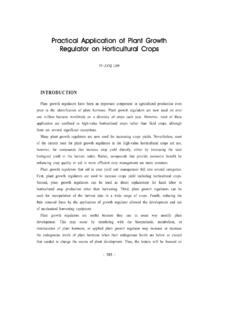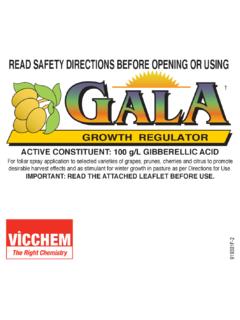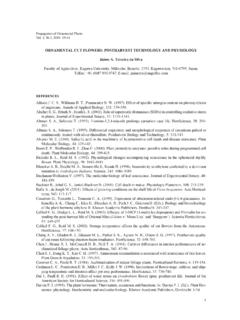Transcription of PLANT GROWTH IN HARMONY WITH NATURE - Kelpak
1 PLANT GROWTHIN HARMONYWITH NATURE +16% ACTIVE COMPOUNDS IN MICRO QUANTITIES :- Alginates- Brassinosteroids- gibberellic acid - Macro and micro nutrients IN SIGNIFICANT QUANTIES :- Phlorotannins (Eckol)- Polyamines Kelpak APPLICATION- Seed coating- Planter application- Root dip- Soil drench- Drip irrigation- Foliar spray conventional, electrostatic or aerial Kelpak BENEFITS- Prolific lateral rooting- Increases GROWTH of seedlings - Increases GROWTH of nursery PLANT -outs - Improves nutrient uptake- Increases photosynthesis- Alleviates the effect of stresses- Increases pollen germination and tube GROWTH - Increases fertilisation - Increases fruit set and retention.
2 Size and colour- Improves shelf-life during cold storageWHY KELPAKThis natural seaweed concentrate utilises a unique process to deliver an end product that is scientif ically proven to have numerous benef icial physiological e ects on plants. Ongoing international research and trialling proves Kelpak s ability to consistently increase the health, quality and yield in a wide variety of crops, with resultant prof its benef iting farmers around the world for over forty SOURCEThe giant brown kelp species Ecklonia maxima, is hand harvested by divers in the clean and nutrient rich waters o the rugged, cold Atlantic coastline of southern Africa.
3 A strict harvesting protocol is followed to ensure uniformity and activity that is essential for the raw material used to manufacture PROCESSThe freshly harvested seaweed is sorted, cut, washed, inspected and gradually reduced. The material is then subjected to high pressure, applying a signif icant degree of potential energy into each particle. When passed at high velocity through a low pressure zone, this stored energy instantaneously expands, causing the cell walls to rupture, releasing the active compounds found in Kelpak . This non-denaturing process avoids the use of heat, chemicals or freezing and is known as Cold Cellular Burst Technology, a proprietary method ref ined over the last four decades.
4 THE RESULTR eturn on investment has proven to be consistently high in global trials. This natural seaweed concentrate o ers numerous benef its, with resultant increased production prof its for the end fruit set and retention, size and colour- Improves shelf-life during cold storageOHOHHO(Eckol)OOOOHOHOHA ctive compounds act individually orin concert, contributing to numerousfavourable physiological responsesKelpak is manufactured using the uniquecold cellular burst process OPTIMAL USAGE- Do not dilute more than 1:500 with foliar application- Do not dilute more than 1:1000 with application through drip irrigation, apply as a pulse during last 10 minutes of irrigation cycle- Do not apply more frequently than 10 days apart- Maintain pH below 7- Compatible with most agrochemicalsKelpak is approved for organic crop production according to Regulations:(EC) No.
5 834/2007 and 889/2008, and USDA/NOP-Final rulePhlorotanninsGLOBAL TRIAL RESULTS:Table grapes berry size yield returns Wine grapes yield increase bunch stretching Melon marketable fruit fruit weight Watermelon fruit weight Marketable yield Carrots ChicoryOnions Head lettuce head weight Leafy lettuce leaf weight Legumes (seed yield) Dry beansGreen beans Peanuts PeasSoybeans +10%+12%+15%+10%+17%+ 5%+ 31% + 11%+15%+ 13% +16%+ 13 % +26%+10%+16%+17 %+17 %Marketable yield Apples CherriesPears Peaches Plums Butternut large fruit yield increase in return
6 Pumpkin increase in return Potatoes dry land yield irrigated land yield seed potato yield Broccoli head weight Cauli ower head weight Cereal crops BarleyCanola MaizeRice Wheat +10%+18%+11%+ 9%+15% +23%+13%+21% +16%+11%+17% +15%+13% +15%+12%+12%+13%+12%+15%+13%+ 8%+15%+14% +50%+11%+12%+ 6 + 21%+25%+ 17% +15%+ 9 % +23%+17%+16%+18%Marketable yield Avocados Bananas Blueberries/RaspberriesCitrus Strawberries Cucumbers PLANT root massfruit/tunnelfruit massshelf-life (days) Marketable yield Field tomatoes Greenhouse tomatoesPeppers Cabbage (large) head weightCabbage (small)
7 Head weight Nut cropsAlmonds MacadamiasPecans Walnuts DOSAGE3 L/ha3 L/ha2-4 L/ha3 L/ha3 L/ha200 ml/100 L water200 ml/100 L water1 L/100 L water500 ml/100 L water200 ml/100 L water3 L/ha 1 L/100 L water3 L/ha2 L/ha3 L/ha4-5 L/ha 1-1,5 L/100 L water3 L/ha2 L/ha2 L/ha2 L/ha250-500 ml/100 L water100 ml/10 L water50 ml/10 L waterCROPALMONDSAVOCADOSBANANASBLUEBERRI ES, POME & STONE FRUITCHERRIESCITRUSMACADAMIASNEW ORCHARD & V INE YA RDPLANTINGSPECANS & WALNUTSSTRAWBERRIESTABLE GRAPES:ALL CULTIVARSB unch stretchingBerry size, uniformityImproved sugarand colourWINE GRAPESB unch stretchingBerry set, uniformity, yield increaseTURF &SPORTS FIELDSGREENSFLOWERS &ORNAMENTALSAPPLICATIONS pray at 50% bloom and repeat twice at10-14 day intervalsSpray with gibberellic acid inhibitor at 50% bloom and repeat 14 days laterSpray pre-bloom and repeat 2 to 3 timesat monthly intervalsSpray at fruit set and repeat twice at 14 day intervalsSpray at 50% bloom and repeat twice at 10-14 day intervals.
8 Optional sprays at straw and 14 days later Spray 3 times between white tip and full bloom Optional spray at fruit set. Spray post-harvest with nitrogen applications Spray start of bloom and repeat 4 timesat monthly intervalsDip bare roots of nursery trees before transplantorSoak seedling bags before transplant, or soak soil around trees after PLANT -out andSpray 3 to 5 times during early active GROWTH at21 day intervals Spray at catkin elongation and repeat twice at14 day intervalsDip the runners in solution at PLANT -out andApply at 21 day intervals, cease application 1 month before end of harvestSpray at 5-10 cm shoot GROWTH Spray in 1000 L water or less after set (4 mm berry size)
9 Repeat 2 to 3 times at 10-14 day intervalsorSpray as above with electrostatic applicators orDip bunches 2 to 3 times at 4-12 mm berry sizeSpray at start of berry softening (veraison) and repeat 14 days later Spray at 5-10 cm shoot GROWTH Spray 2 weeks before flowering and repeat at start of flowering to 30% bloomSpray at start of growing season and repeat 14 days later. Repeat sprays after summer heat stressApply 20 L solution to 100 m2 and repeat monthlyUse higher application rate with establishmentDip tray with seedlings in solution, or wet seedling tray/bag before transplantandSpray 14 days after emergence or transplant and repeat at 21 day intervals DIRECTIONS FOR USES uitable For Application With Electrostatic Spray EquipmentGround Application: Apply in up to 500 L water per ha.
10 It is advisable to use a surfactant in the spray solutionAerial Application: Apply in 30 L water per haOrchard Application: Volume determined according to tree-row-volumeDOSAGE1 L/100 L water2-3 L/ha2 L/ha1 L/100 L water3 L/ha2 L/ha1 L/100 L water2 L/ha2 L/ha500 ml/100 L water1 L/ha3 L/ha2 L/ha2 - 4 L/ha 3 - 4 L/ha350 ml /100 L water 2 L/ha2 L/ha1 L/1000 L water2-3 L/1000 L water2-3 L/1000 L waterAPPLICATIONDip seedling tray with seedlings in solution, or wet seedling tray with a watering can before transplantingandSpray 14 days after transplant and repeat once or twice at 14-21 day intervalsStart sprays at 3 to 4-leaf stage for direct seeded plantsSpray at 4 to 5-leaf stage and repeat14 to 21 days laterDip seedling tray with seedlings in solution, or wet seedling tray with a watering can before transplantingandSpray 14 days after transplant and repeat14 to 21 days laterStart sprays at 3 to 4-leaf stage for direct seeded plantsSpray between V6 (6-Trifoliolate) and R1 (start of flowering)




